The Ultimate Travel Guide to Xinjiang
Xinjiang, officially Xinjiang Uyghur Autonomous Region, is located in the northwest corner of China. As the largest province-level division of China, it covers over 1.66 million square kilometers (640,00 square miles), about one-sixth of the country’s total territory, with the longest borderland and most adjacent countries.
Whether you prefer exceptional natural beauty or enchanting Central Asian history and culture, Xinjiang is the place for you. There are so many absolutely beautiful places throughout Xiangjiang, that you will be kept busy photographing it all. From the vast grassland, crystal lakes, and golden birch forests, to the endless desert, unbearable hot flame mountains, and desolate Yardang landforms. The ancient prosperous Silk Road has shaped the region’s rich and profound multiculturalism, which attracts countless travelers to retrace the footsteps of Marco Polo to explore life as it has for centuries, based on the ruins of lost cities, bustling bazaars, sacred mosques, and lively tea houses.
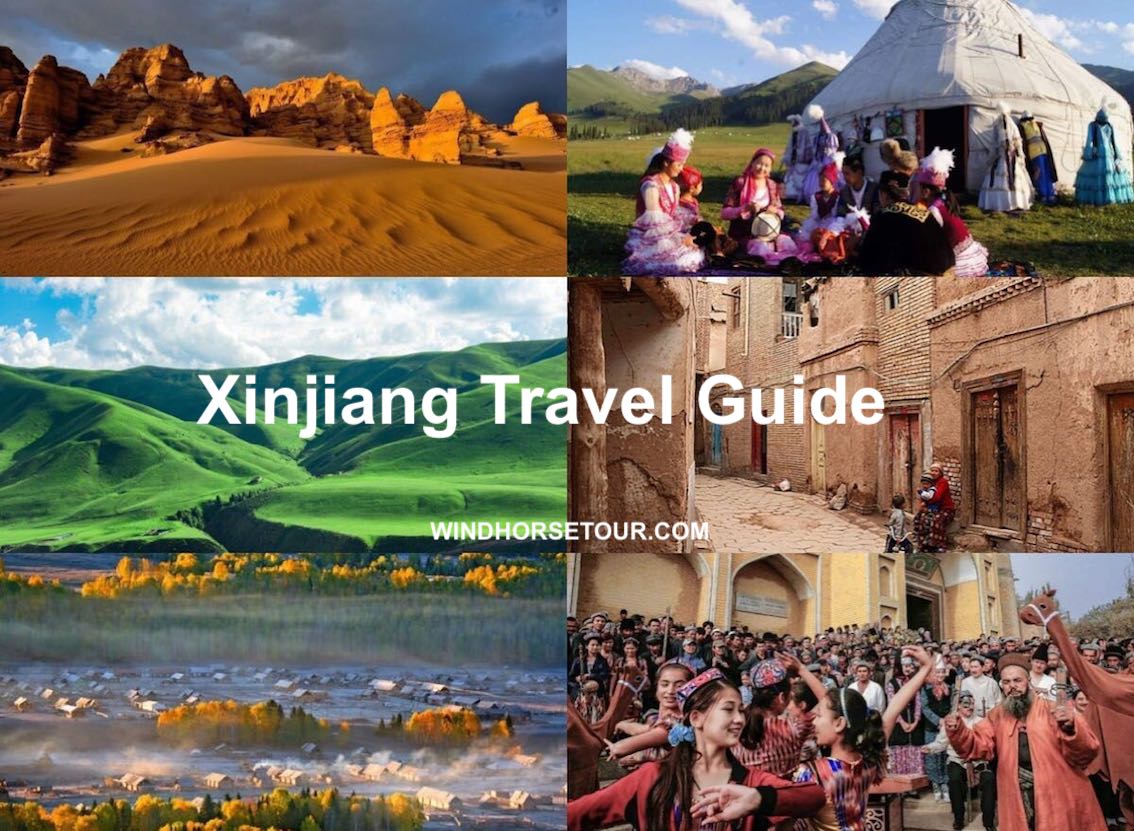
The magical Tianshan mountain range separates Xinjiang into two distinct regions with different landscapes and cultures, namely Dzungaria north of the Tianshan Mountains (also known as northern Xinjiang) and the Tarim Basin south of the Tianshan Mountains (also known as southern Xinjiang). Northern Xinjiang is dominated by natural scenery, with a long history of nomadic culture, alpine grasslands, and galloping horses. While Southern Xinjiang is famous for its unique history, culture, and diverse agricultural civilization, with the perfect combination of desert and Gobi.
Xinjiang is filled with amazing experiences that will touch your soul and leave a deep impression with you forever. It is the indispensable section during your China Silk Road tour.

Xinjiang Weather and Best Time to Travel
As a landlocked region in northwest China and is surrounded by towering mountains, Xinjiang boasts a temperate continental climate with low rainfall percentages, strong wind, and large temperature differences between day and night. The old Chinese saying “Have a cotton-padded jacket to wear in the morning and yarn to wear in the noon; Eat watermelons around the stove.” perfectly describes the weather in Xinjiang. The weather also differs a lot in northern Xinjiang and southern Xinjiang. Northern Xinjiang is always getting colder than southern Xinjiang.
1. Based on the different regions
The best time to visit northern Xinjiang is from June to September. June to August is an excellent time to appreciate the purple lavender fields and the golden sea of rapeseed flowers. The Switzerland-like scenery composed of grasslands, lakes, and snow-capped mountains will also reach its best during the period. In September, Kanas Lake and its surrounding gradually turn into a colorful autumn landscape, with golden birch forests dotted by Tuva houses, making a paradise favored by photographers.
Southern Xinjiang is a year-round travel destination for its culture and history which are not restricted by the weather. The best time to visit southern Xinjiang is from August to October when the weather is comfortable and cool without sandstorm in spring, and not so hot nor cold.
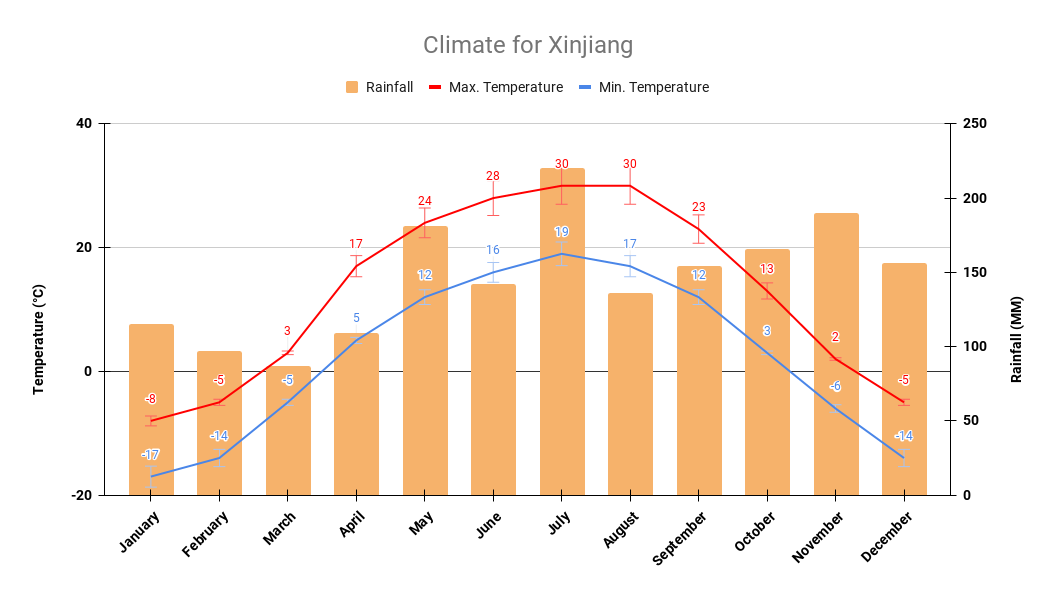
2. Based on different seasons
Spring (March to May): The cold ocean air brings frequent strong winds and dust storms in Xinjiang during Spring. As such, it's not widely considered to be a good time to visit Xinjiang. However, the vivifying grasslands still attract a lot of attention with blooming flowers, countless cattle, and sheep.
Summer (June to August): Summer is definitely Xinjiang’s peak travel season, and this has a lot to do with school holidays. The weather is very hot throughout much of Xinjiang in the summer months, especially in the basin and desert. But you can also seek out cooler weather in the mountainous regions, like the Tianshan Mountains, Kunlun Mountains, and the Altai Mountains.
Autumn (September to November): Autumn is an ideal time to visit Xinjiang. It's still warm out during the day with clear skies and light winds, but the excessive summer heat is gone. As the autumn season wears on, the leaves on the birch trees and poplars change from green to golden-yellow. The result is some very pleasant sightseeing and photography opportunities.
Winter (December to February): Winter is chilly in Xinjiang with temps always falling below zero, especially in mountainous regions, with the average highs being at -5˚C. Heading down from the mountains to the Turpan Depression can see temps at -1˚C on a winter day, and if you continue south to Kashgar, the daytime temps in the winter are likely to be 10˚C. During this long-lasting winter, Xinjiang becomes a snow world for travelers like skiing and skating.

Places Not to Miss in Northern Xinjiang
1. Kanas Lake
Kanas Lake is located in a valley of the Altai Mountains (northwest corner of Xinjiang), close to the borders between Kazakhstan, Russian, and Mongolia. “Kanas'' meaning “beautiful, rich and mysterious” in Mongolian, is the perfect definition of this land. The winding Kanas Lake flows through the mountains, flanked by thick birch and pine forests. It feels like a slice of Norway or Switzerland when roaming on the quiet paths along the riverbanks, encountering Kazakh s and Tuva villages dotted on the verdant grasslands and pastures. In addition, the rumors of the Kanas Monster simply add a mysterious charm to the lake.
2. Koktokay National Geopark
Koktokay National Geopark is located in Fuyun County of Altay Prefecture. Being dubbed as “China’s Yosemite”, Koktokay National Geopark boasts the Altay granitic geomorphologic landscape, and it is also listed as a UNESCO World Geopark. Composed of four main parts: Kara Siegel Earthquake Fault Zone, Cocoa Sullivan Lake, Ilyamu Lake, and Irtysh Grand Canyon, it features unrivaled natural beauty, such as valleys, wetland, forests, and mines. A visit to Koktokay National Geopark is a true delight for any group, especially for those who love hiking, photographing, and scientific investigation.
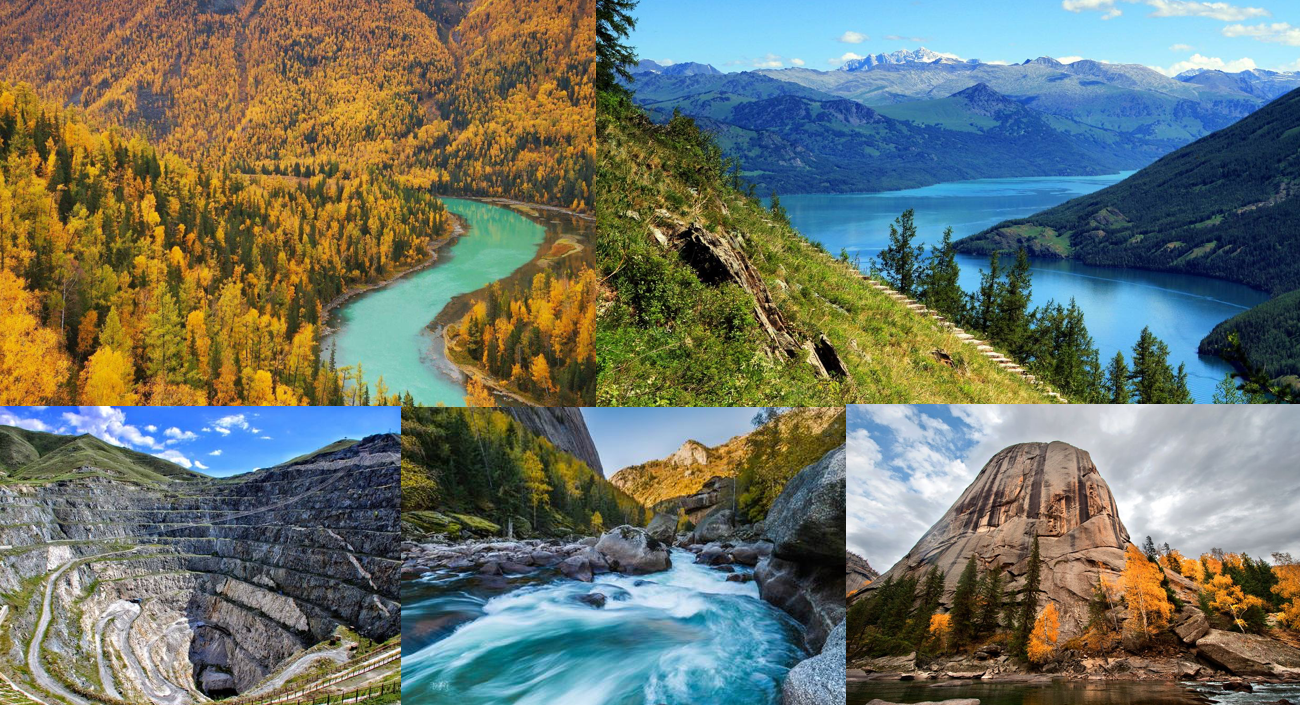
3. Multi-colored Bay
Located in Burqin County of Altay Prefecture, Multi-colored Bay is on the only way to Kanas Lake. Formed by water and wind erosions, it is a typical Yardang landform with rainbow hills and queer rocks. Separated by the Irtysh River, Multicolored Bay offers different views on its south and north bank. The south bank is decorated with dense poplar forests, colorful flowers, and running herds. When the poplar turns golden in autumn, it is the best time to appreciate the vivid natural scenery with a wonderful reflection in the river. While the north bank features amazing hills with dazzling colors, which gets most beautiful before the sunset. Under the sunlight, the hills seem to be burning, like a palette knocked over the beach.
4. Karamay Ghost City
The Ghost City also called the Wind City of Urho, is situated about 100km from Karamay city. The Ghost City is famous for the unique Yardang, which comes to the top of “Three Most Beautiful Yardang Landforms in China” selected by Chinese National Geography. Under long-term erosion of wind, the ground forms gullies with varied depth, and the strong wind has carved the exposed stone layers into distinct peculiar shapes, with colorful stones scattered, like gems left by fairies. When there are strong winds roaring through the city, the sky is covered by the sand and the dust, it is like howling ghosts making the place even more mysterious. Hence it got the name “Ghost City”.
5. Tianchi Lake
Tianchi Lake which literally means Heavenly Lake is a natural alpine lake shaped in the Quaternary Glacial period, facing the north face of Bogda Peak in Fukang, about 97km from Urumqi. The magnificent snow-capped mountains set the background for the greenish lake, providing a picture-postcard view for travelers strolling along the mountain paths, or roaming in the lake by boat. Apart from the stunning scenery, Tianchi Lake also offers a few historical sites and cultural relics for exploration, with unforgettable overnight at the authentic Kazakh yurts.
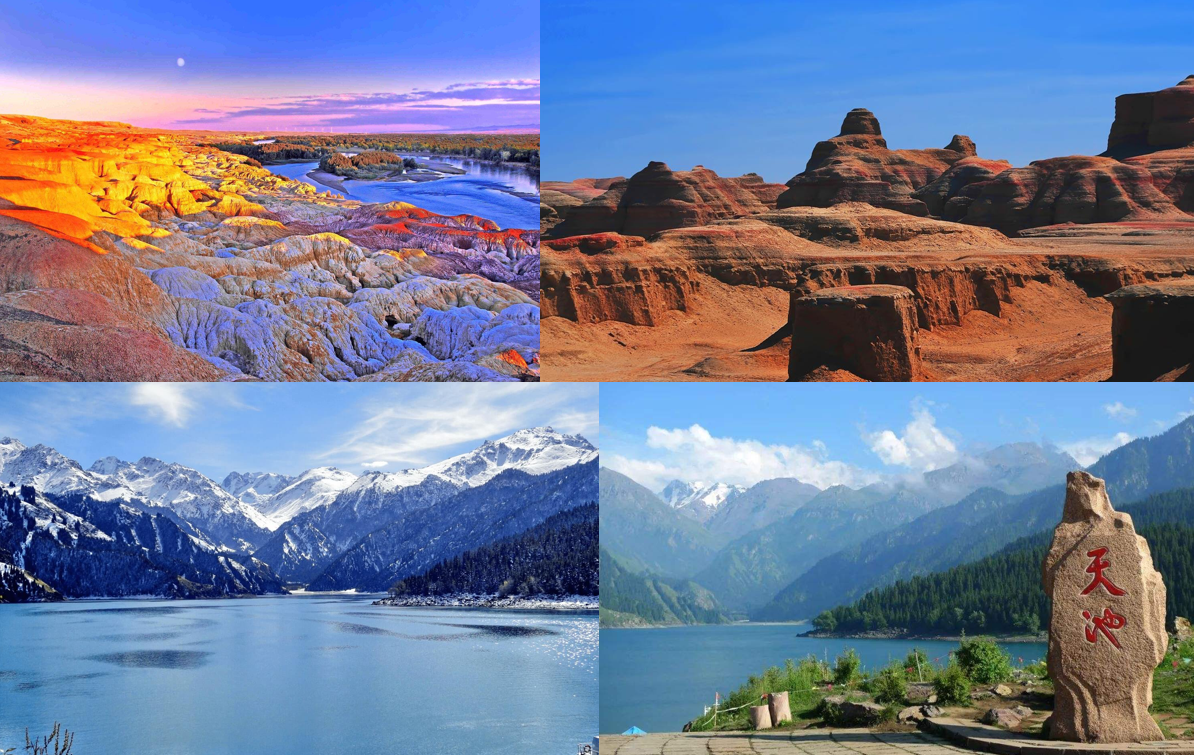
6. Sayram Lake
Sayram Lake [2,070m], the largest and highest alpine lake in northwest Xinjiang, is situated in the Bortala Prefecture. Sayram means “blessing” in Kazakh, and the lake was called the “Clean Sea” in Ancient China. As it is the last place reached by the warm and humid air current from the Atlantic Ocean, it is also renowned as the “Atlantic Ocean’s last teardrop”. Framed by the majestic Tianshan Mountains in the background, the turquoise lake is a pearl over the prosperous cedar trees covered mountain basin. By its lakeside, the rolling pasture is dotted by herds of horse and sheep, as well as traditional Kazakh yurts.
7. Bayanbulak Grassland
Bayanbulak Grassland, the second largest grassland in China, is located in the Hejing County in the Bayingolin Mongol Autonomous Prefecture. Situated in the Bayanbulak Basin of Tianshan mountains and surrounded by snow-capped mountains, Bayanbulak Grassland is a hidden paradise boasting the elegant Swan Lake and the charming Nine Turns and Eighteen Bends. With boundless grass meadow and numerous lakes, it is the ideal pasture for the galloping horses, as well as grazing sheep and yaks. As the home for 9 ethnic groups including Mongolian, Han, Tibetan, and Kazakhs, it is also a great place to experience local customs, especially during the Nadam Fair held from June 4th to 6th in the Chinese lunar calendar.
8. Narat Grassland
Narat Grassland is located in the east of Narat Town, Xinyuan County, Ili Kazakh Autonomous Prefecture. As one of the world’s subalpine meadow plant areas, it is praised as the “Sky Grassland”. Kissed by the first ray of sunlight, the grassland is also called the “first place to see the sun”. Settled between the rolling mountains and deep valleys, the grassland is like a huge carpet with pearl-like yurts scattered and snow-covered peaks accompanied. With the most populated Kazakhs in China, the grassland is an open-air museum that reflects and showcases the traditional living habits of the Kazakhs.
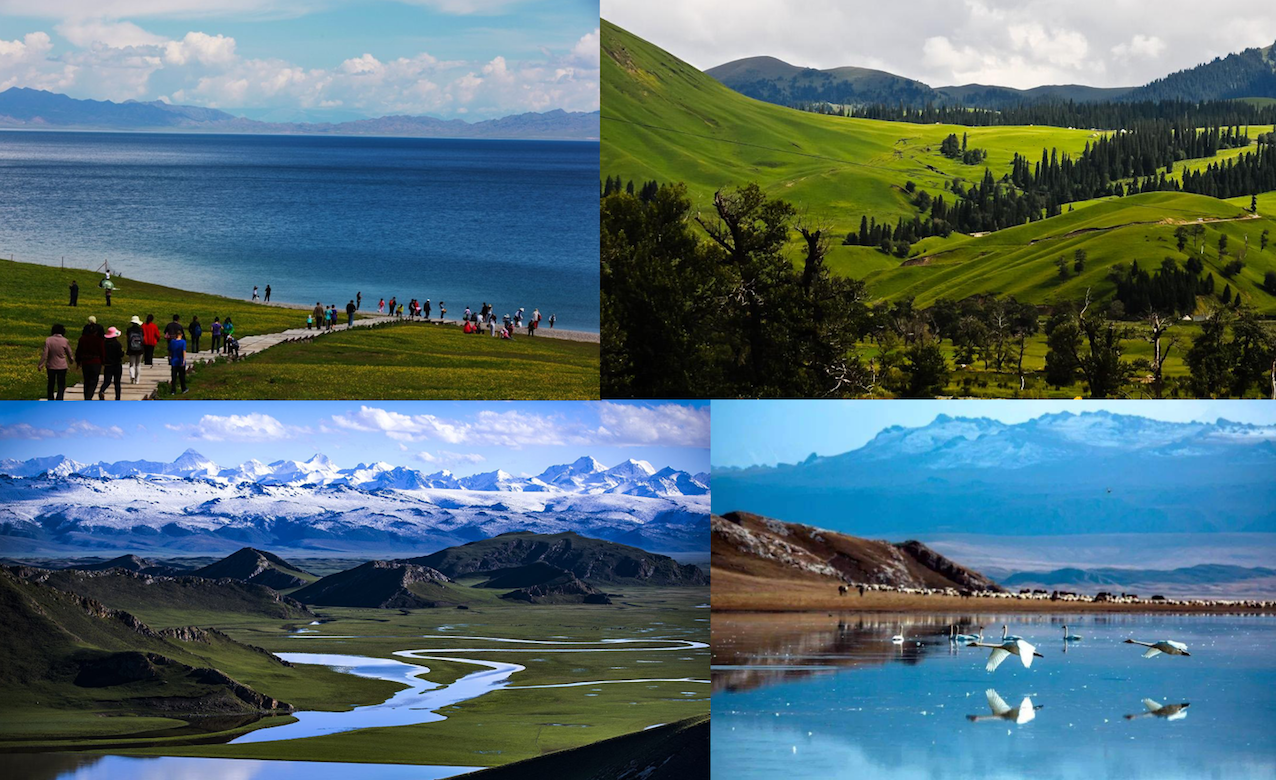

Places Not to Miss in Southern Xinjiang
1. Jiaohe Ruins
Jiaohe Ruins is nestled on a leaf-shaped plateau in the Yarnaz Valley, about 10km west of Turpan. The ancient city was built by the Jushi people between two deep river valleys and was thus named “Jiaohe” which means “where two rivers meet” in Chinese. With a history of over 2,300 years, it is the world’s largest, oldest, and best-preserved earthen city. It was the capital of the Jushi Kingdom and became a major trading center along the Silk Road. A stroll through its central avenue can take travelers back to the hub of the Silk Road, with access to its well-preserved residential districts and entirely reserved religious sites, such as Buddhist temples and stupas.
2. Karez Well
Karez Well is located in the Turpan Depression. “Karez” means “well” in the Uyghur language, it is a great irrigation system initiated by the ancient people who dig a series of vertical wells that channel water from the base of the Tianshan Mountains and the nearby Flaming Mountain into the underground water canals and eventually channel the water to the surface. Playing an important role to nourish the crops, breed the people in the oasis Turpans, and serve caravans on the Silk Road, Karez Well is known as one of the three great projects in ancient China, along with the Great Wall and Grand Beijing Hangzhou Canal.
3. Bezeklik Thousand Buddha Caves
Perched on the cliff of Mutou Valley under the Flaming Mountains, about 45km east from Turpan, Bezeklik Thousand Buddha Caves are complex of religious caves and shrines dating back to the late Southern and Northern Dynasties Period (AD 420-589). “Bezeklik” means “a well-decorated place”, which reveals the previous splendor of the caves, although they have suffered great damage for years. The remaining exquisite and gorgeous murals provide evidence that the Bezeklik Thousand Buddha Caves mark the earliest development of Buddhist cave art in the country.
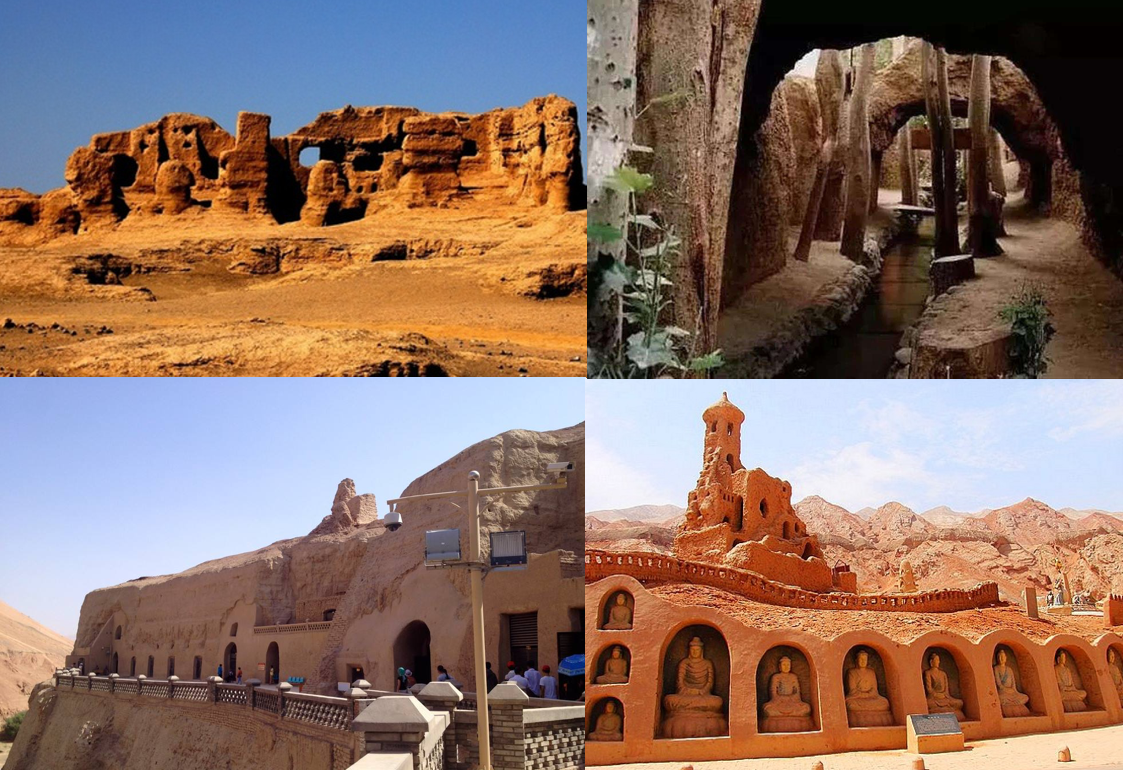
4. The Flaming Mountains
The Flaming Mountains, like a red dragon stretching from east to west in the north Turpan, form a natural boundary between Turpan and the Taklamakan Desert. The Flaming Mountains were called Red Rock Mountains in ancient times and gained their current name due to the classic Chinese novel “Journey to the West”. The eroded, barren, red sandstones form remarkable gullies and trenches, which looks like a blaze of fire dancing in the sands under the scorching sunlight. As the hottest place in China, the climate here is extremely harsh with temperatures searing at 80 °C (175 °F) during the summer months.
5. Taklamakan Desert
Taklamakan Desert, the largest desert in China, is located in the middle of the Tarim Basin in the southwest of Xinjiang, with the Tianshan Mountains, the Kunlun Mountains, the Pamir Mountains, and the Gobi Desert surrounded. Being part of the Silk Road for merchant caravans, Taklamakan Desert is a witness to the splendid history and ancient civilization of the lost cities. A drive on its desert highway through the boundless yellow sand under the unbounded blue sky is undoubtedly a memorable journey of a lifetime. Get atop of the distinctive sand dunes in red and white, travelers can get an eye-catching view of the wind-eroded mushrooms, as well as the spectacular overlooking of golden Populus euphratica forests.
6. Tianshan Grand Canyon
Tianshan Grand Canyon is 64km north of Kuqa in Aksu Prefecture. As a branch of the Tianshan Mountains, the mysterious Tianshan Grand Canyon is composed of ranges of reddish-brown rock massif. Thus it is also called Keziliya Grand Canyon, as “Keziliya” means the “red cliff” in the Uyghur language. Thanks to the wind and rain erosion of millions of years, the distinct colored rocks make the canyon a masterpiece of nature. The charm of the canyon lies not only in its majestic and precipitousness but also in its serenity and mystery. Standing at the bottom of the valley and looking up at the mountains, travelers can feel that the steep peaks seem to be pressed down at any moment.
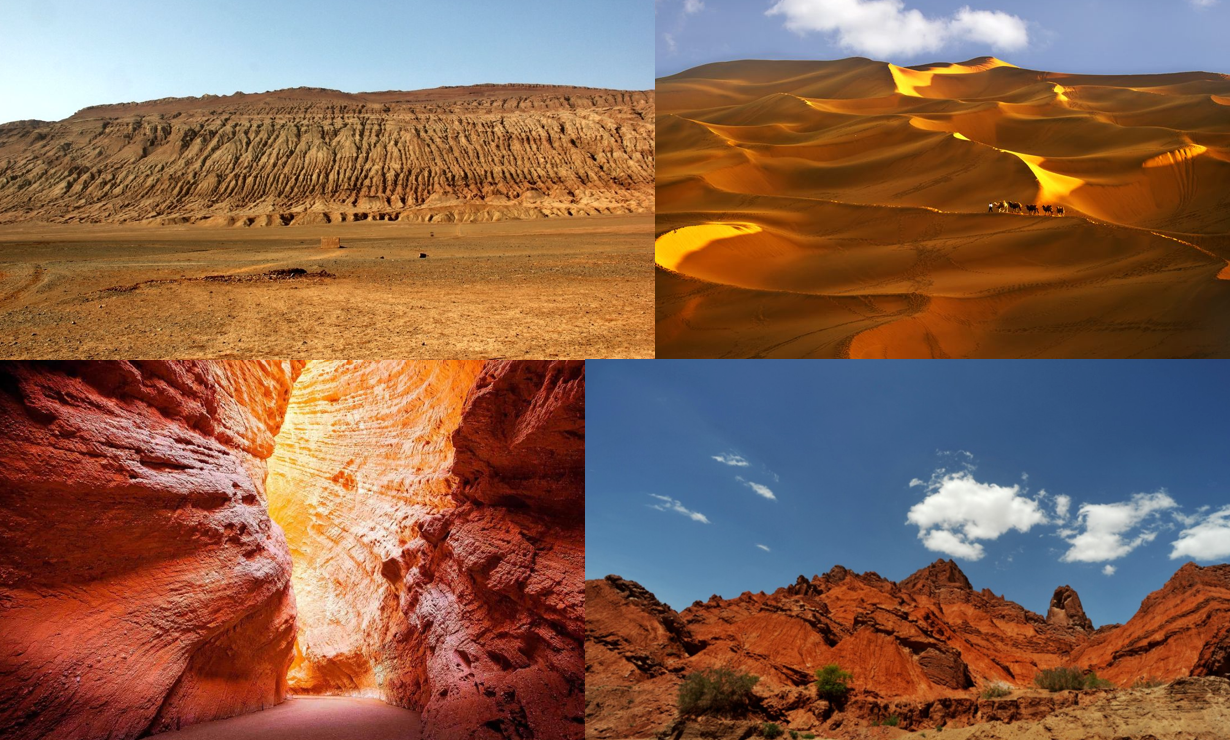
7. Kizil Thousand Buddha Caves
Kizil Thousand Buddha Caves, a complex of Buddhist rock-cut caves, sit in Kizil town, Baicheng County of Aksu Prefecture, facing the Muzat River to the south. Known as the “treasure house of Buddhist art”, it is the earliest major Buddhist cave complex across China and the largest cave art site in all of Xinjiang, housing fascinating craftsmanship in cave architecture, sculpture, and murals. Inspiring the development of Buddhist art in Dunhuang and the Central Plains of Han, it made great contributions to the splendid ancient civilization of the West region and the gradual dissemination of Buddhist culture and art, with invaluable art and cultural relics.
8. Kashgar Old Town
Kashgar Old Town, the soul of Kashgar, lies in downtown Kashgar which has been a focal trading hub on the ancient Silk Road as the western gateway in China. The old town is a large adobe complex made of yellow mud bricks, inhabited by Uyghurs, the largest ethnic group in Xinjiang. Wandering through this unique maze city and exploring its narrow alleys lined with Uyghur workshops and adobe houses which have withstood the elapsed time and yet remain vibrant, travelers can have an apparent sense that they are in more Central Asia than China. As one of Central Asia’s best cases of traditional Islamic architecture, it was the filming location of the movie “The Kite Runner”.
9. Id Kah Mosque
Id Kah Mosque, an ancient Islamic architecture complex built in the fifteenth Century with intense ethnic and religious features, is located at the west of Id Kah Square in Kashgar. With the recognizable golden bricks, it is the true heart of Kashgar, both spiritually and physically. Covering 16,800 square meters, it is the largest mosque in Xinjiang and one of the largest mosques in China. “Id Kah” is taken from the Persian word “Eidgāh” which means “Place of Festivities”, thus the mosque has become a gathering place for Muslims from all over Xinjiang. It houses about 6,000 - 7,000 worshippers every Friday and can hold up to 20,000 worshippers during the annual Qurban Bayram.
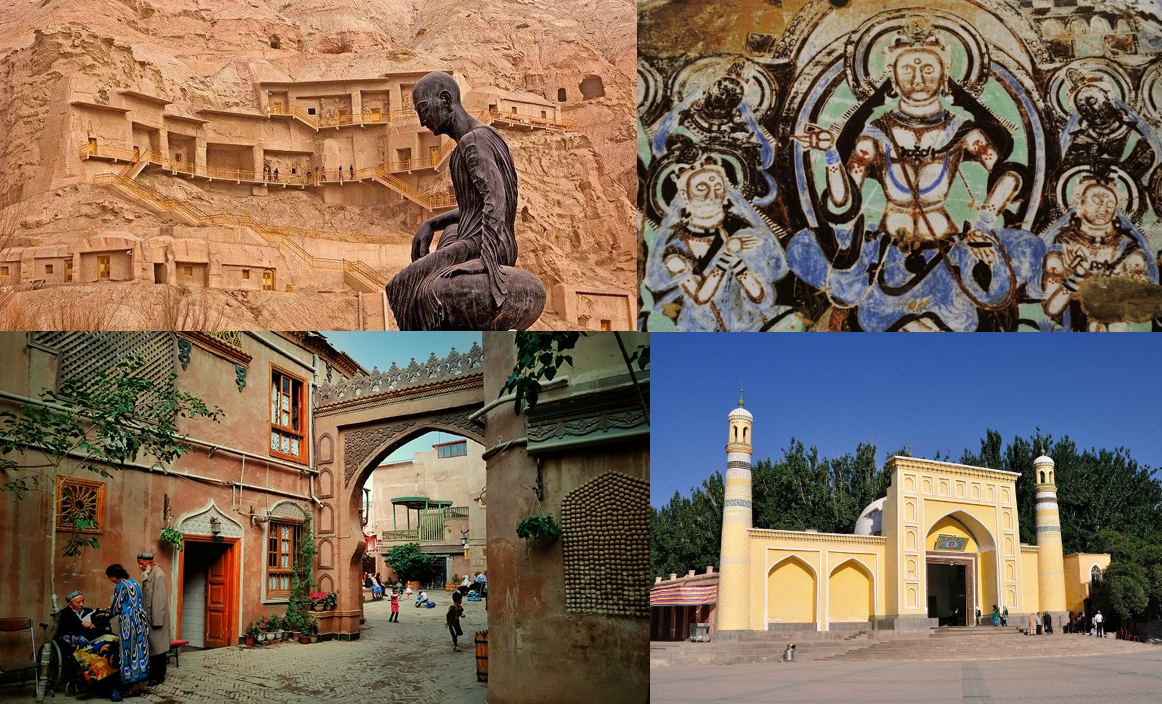
10. Sunday Bazaar
Sunday Bazaar, also known as Sunday Livestock Market, is located about 6km southeast of downtown Kashgar. The bazaar is active every day for silks, carpets, food, clothes, etc. to suit local and foreign tastes, but it’s on Sundays that things really get going when Uyghur farmers coming from nearby villages, with their vendable livestock squeezed through the bazaar gates. Although it’s crowded, dusty, and smelly, the Sunday Bazaar provides an unrivaled opportunity for a glimpse into local life. No trip to Kashgar is complete without a visit to the Sunday Bazaar, as visiting a bustling market is the best way to understand a foreign culture.
11. Karakul Lake
Karakul Lake [3,600m], the highest lake on the Pamir plateau, sits at the foot of Muztagh Ata [7,546m], about 191km southwest of Kashgar. The surrounding snow-capped mountains, especially the Muztagh Ata [7,546m], Kongur Tagh [7,649m], and Kongur Tiube [7,530m] add extraordinary charm to the lake. “Karakul” means “black lake” in the Turkic language, and it indeed looks black on cloudy days. While in the sunny days, the lake changes from various tints of emerald and turquoise to light blue and cerulean. Famed for its color-changing water and excellent reflections, it is a paradise that can be reached by an epic road trip through the Karakoram Highway.
12. Tashkurgan Stone Fort
Tashkurgan Stone Fort is located in the north of Tashkurgan Tajik Autonomous County. Built as the seat of various ancient kingdoms and served as a former Silk Road outpost, this over 2000-year-old stone fort gives the town of Tashkurgan its name. Climbing up the fort with a stroll through the ruins of what must have once been quite an impressive fortress, travelers can be rewarded by the spectacular commanding view of the splendid Aral plains with Tajik yurts dotted and majestic snow-capped mountains behind, as well as the picturesque grasslands extending as far as the eye can see.
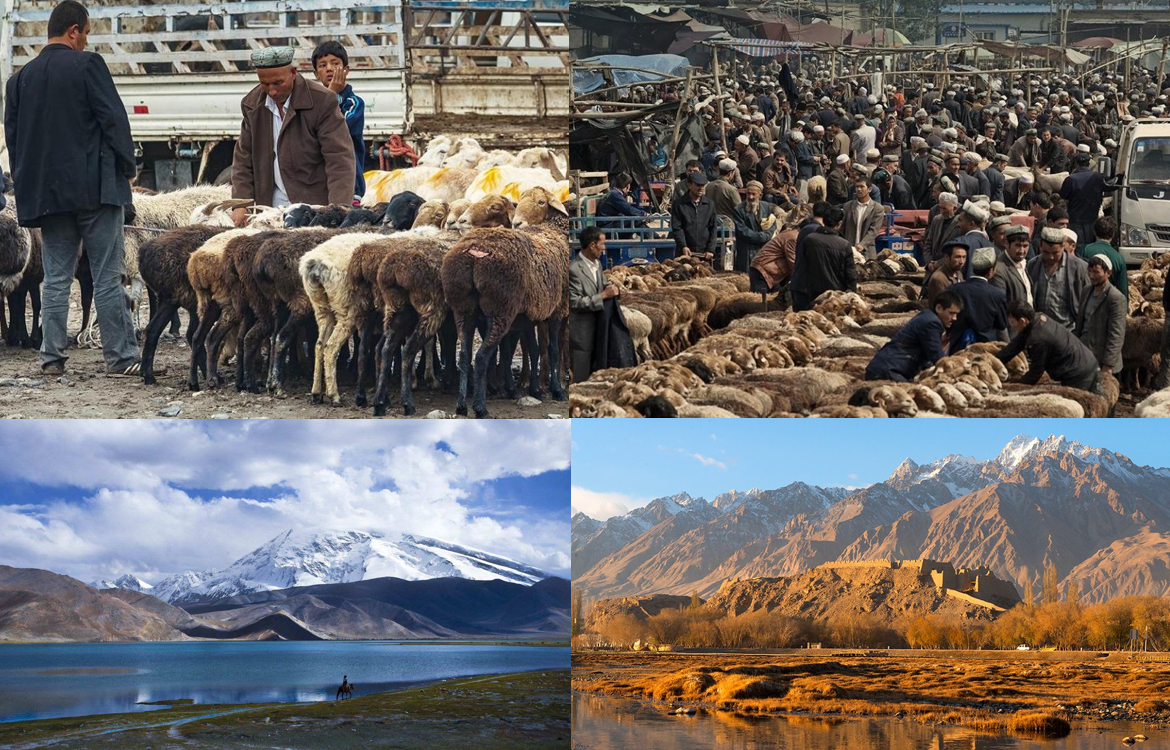

How to get to Xinjiang and travel within Xinjiang
There are numerous ways to enter Xinjiang, by air, train, coach, or a private car. For most travelers who travel in Xinjiang only, their choice is either flight or train, and their first stop is usually Urumqi. There is also a small number of people coming by private car from neighboring provinces, such as Gansu, Tibet.
Taking a flight is the fastest way to get in and out of Xinjiang. Urumqi Diwopu International Airport is the main airport serving travelers coming to Xinjiang. Most China-based airlines operate direct flights into Urumqi from a variety of major cities, such as Beijing, Xi’an, Lanzhou, Chengdu, etc. It only takes 4 to 5 hours from Beijing to Urumqi, but it takes up to 30 hours by train.
However the cost of a ticket is extremely high, so the train is an alternative choice for budget travelers. The Lanxin High-Speed Rail Line operates Lanzhou and Urumqi, with a stop in Turpan, making it possible to travel to Xinjiang within 4-12 hours from many major cities on Silk Road travel, such as Xining, Jiayuguan, and Liuyuan (near Dunhuang).

For traveling between cities in Xinjiang, booking a private car with a local China travel agency is the top choice. Because most beautiful scenery is relatively scattered on the vast land of Xinjiang, traveling by a private car can make the most of travel day, and travelers can also better enjoy the scenery along the way with their own special stops added.
Xinjiang is the province with most domestic airports. With Urumqi as the center, the airlines have opened to more than a dozen regions including Yining, Altay, Turpan, Hami, Kashgar, and Hotan. The fastest way to travel between cities in Xinjiang is by air, but the flight fare is usually high, and travelers can't enjoy the scenery of the road. During the off-season, some airlines may be reduced or even canceled. In addition, as most of the airports are located in the city outskirts, it takes a long time to get in/out of the city. Therefore, most travelers will not choose this way to connect their destinations. However, for travelers who are traveling between far away cities with limited time, a direct flight can be a good option.
Trains are a cost-effective way to move between the cities in Xinjiang, although there are not many railway lines in Xinjiang and most trains take a long time. The train can reach important cities such as Urumqi, Turpan, Hami, Altay, Yining, Kashgar, and Hotan. However, the train goes on a fixed line, which is unable to cover most highlights.

Recommended tour and itineraries for Xinjiang
Xinjiang has a vast territory, offering trips from 1 to 30 days to explore its snow-capped mountains, beautiful lakes, verdant grasslands, boundless deserts, and unique ethnic cultures and religions. Our itineraries below will give you inspirations for what is possible to discover a rare side of Xinjiang that stuns with both nature and culture. Whether you are planning a first-time trip or a depth trip to Xinjiang, there is always an idea that suits you.
- For a summer vacation to escape the hustle and bustle of city life, a tour to the verdant grassland is the first choice. Check out this 8 days North Xijiang grassland tour that shows you the two biggest grasslands in Ili - Narati Grassland & Bayanbulak Grassland, with the unspoiled alpine lake - Sayram Lake.
- For travelers who love photography and hiking, we’ve got a 10 days Xinjiang Kanas Lake and Hemu Village trekking tour that’ll take you through some of the best of northern Xinjiang. The trip begins from Urumqi, goes as far as northwest, and stumbles upon Kanas Lake, which will amaze you when you trekking to the picturesque Hemu village and soaking in the peaceful lifestyle and ethnic cultures of the locals.
- For an in-depth look and to explore the ancient Silk Road and its lasting impact, make a trip to Southern Xinjiang. Here’s a 12 days Silk Road desert highway adventure that’ll get you across spacious deserts and through the relics of lost cities, marvel at mummies in Urumqi, enjoy Uyghur hospitality in Turpan, find enlightenment in Kizil Thousand Caves in Kuqa, and glance at the vanishing Kashgar.
- For travelers who want to see more than above mentioned, our professional travel advisor is here to help you plan your unique experience and make memories that will last a lifetime.

Accommodation and Dining in Xinjiang
With more and more domestic and overseas travelers heading to Xinjiang, accommodation conditions in various parts of Xinjiang are improving day by day. Generally speaking, travelers can find lodges/hostels, family inns, and standard business hotels in most cities, which range from CN¥ 200 - 500. But the luxury hotels can only be found in Urumqi, the provincial capital of Xinjiang. Please note that in remote areas there are only a few hotels with the authority to accommodate foreign guests, for example, Tashkurgan has only one or two hotels available for foreigners. Therefore, it’s better to double confirm prior to departure.
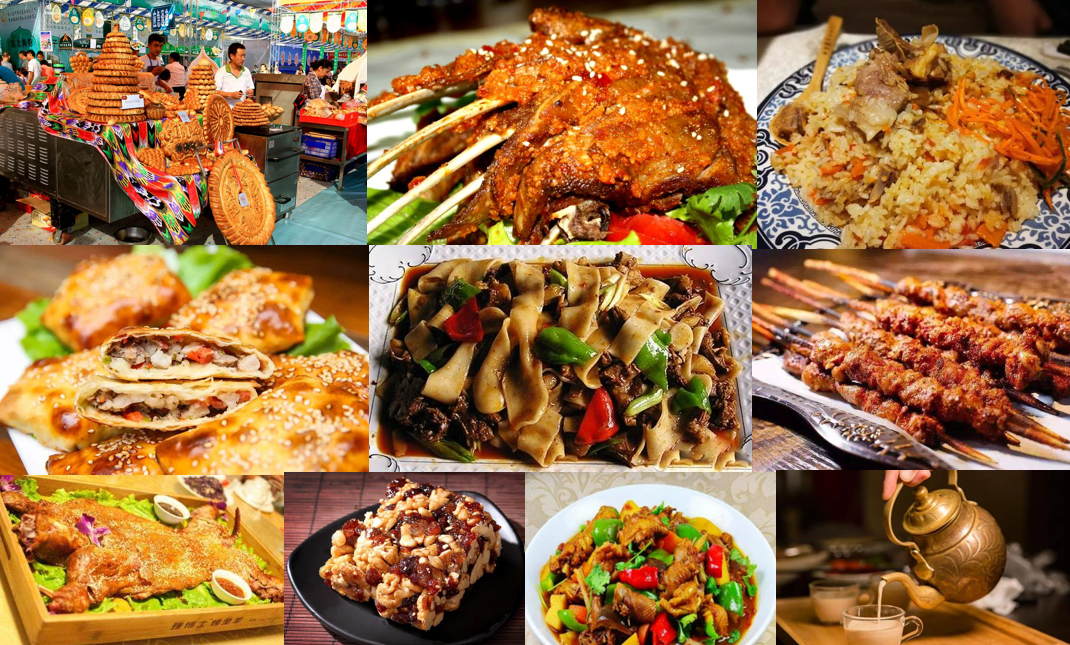
Xinjiang is dominated by the Uyghur ethnic minority and other Muslim groups such as the Hui and Dongxiang people, so the food is mostly halal without pork. With many cities as oasis towns along the Silk Road, Xinjiang flavor is also influenced by numerous nationalities, such as Tibetans, Mongolians, Persians, Turkish. Thickly fragrant spices and seasonings are used liberally in Xinjiang cuisine, making it different from other styles across China. Signature dishes include roasted mutton, kebabs, Dapanji (Big Plate Chicken), Pilaf Rice, and sugary sweet desserts. For vegetarians, Laghman, nan, Samsa, or Sangza can make a meal that is both filling and comforting.

Useful Travel Tips
- Due to the high inter-ethnic tension between Han Chinese and the Uyghurs for the last decade, we advise you to avoid talking politics or any discussion with people about the current Uyghur/Xinjiang situation while in Xinjiang. It’s best to travel, observe, and take your opinions back home.
- The Chinese government has taken a hardline approach in putting Xinjiang under police control. Please be aware that travelers will experience security checks everywhere in the province, and be scanned and searched in all public places, ranging from markets to shopping centers, as well as hotels.
- Xinjiang is always in a state of flux with respect to which place is open or closed for foreigners, so we advise you to do a final check before confirming your travel plans.
- Please do not eat pork or speak about pigs in Muslims’ presence, and respect the customs and habits of ethnic minorities.
- Xinjiang time is two hours behind Beijing time, though the 'clock time' in Xinjiang is just the same as the rest of the country. In this case, please be advised to adjust your rest and dining time accordingly if you have been in other cities of China, otherwise you may feel out of tune with local life.


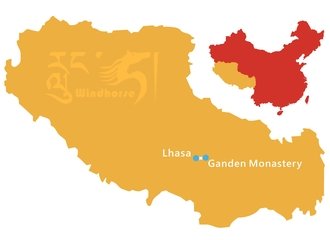
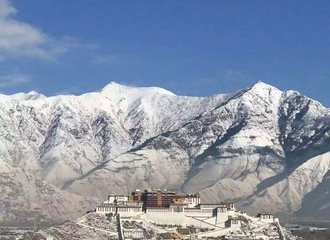
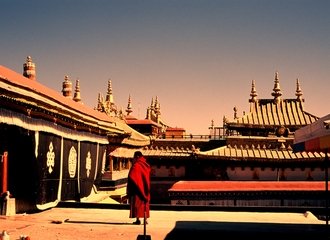
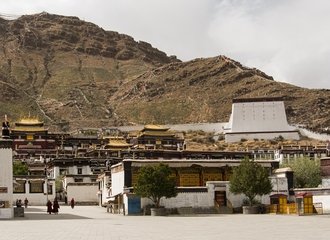
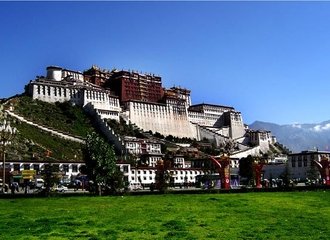
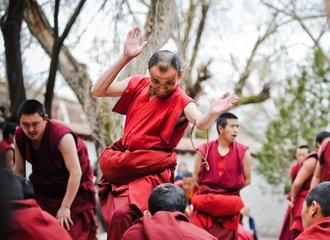
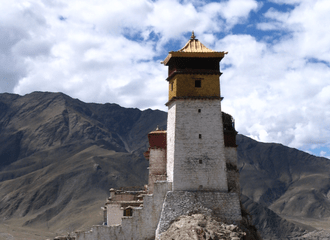
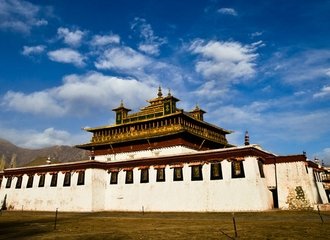
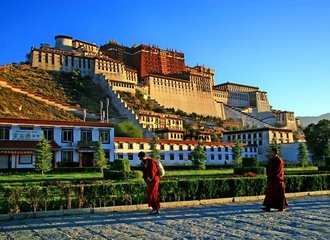
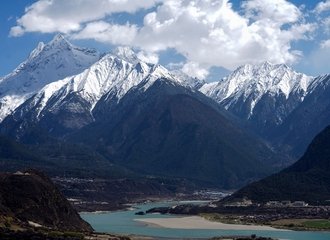
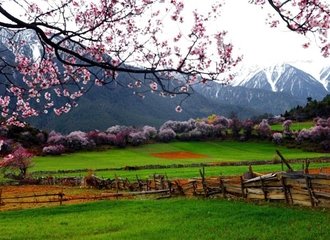
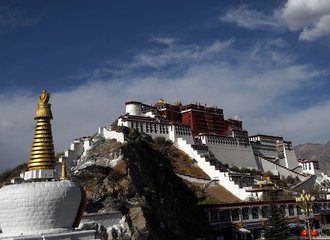

Comments
Any itinerary for North Xinjiang Autumn 12D